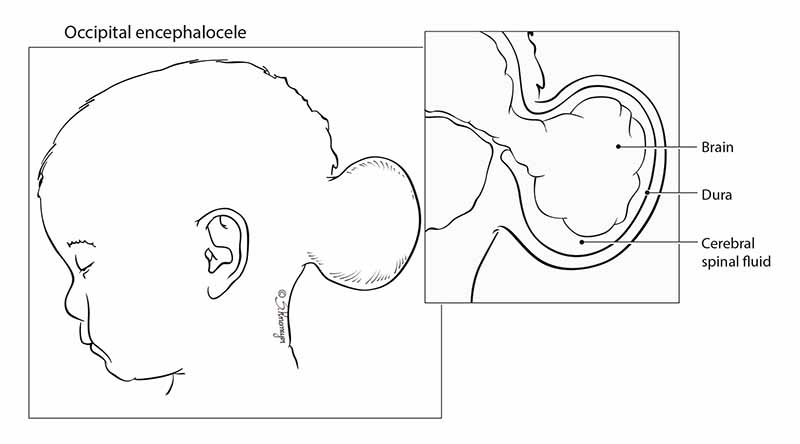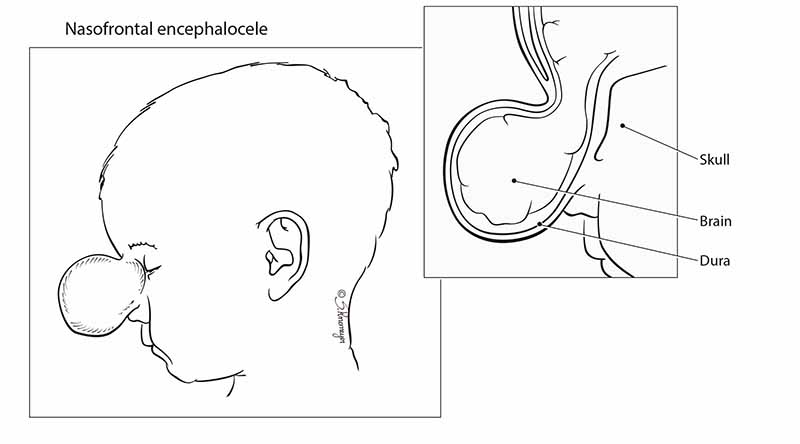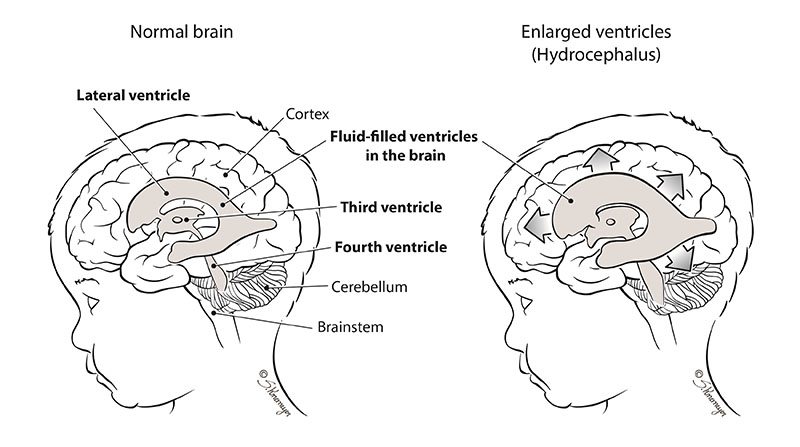Encephalocele
Encephalocele is a rare congenital condition where the neural tube does not close and causes a sac-like bulge with brain tissue and spinal fluid that pokes through the skull.
What is Encephalocele?
Encephalocele (pronounced en-sef-a-lo-seal) is a rare condition that happens before birth (congenital). Normally, the brain and spinal cord form during the third and fourth weeks of pregnancy. They are formed out of the neural tube. Most encephaloceles happen when the neural tube does not fully close. This should happen when the baby’s brain, nervous system and skull are first starting to form. When the neural tube does not close, it can cause a sac-like bulge with brain tissue and spinal fluid that pokes through the skull. An encephalocele can be life-threatening. How serious it is, the treatment and the baby’s chance of living depend on where it is on the skull. Babies with an encephalocele often have chromosome, brain and facial problems as well. While scientists do not know what causes encephaloceles, there is proof that women who eat a lot of foods with folic acid (Vitamin B9) when they are pregnant are less likely to have a baby with the condition. Certain types of encephaloceles are also more common in women with diabetes.


How is Encephalocele Diagnosed?
When you are pregnant, there are a few tests (called prenatal tests) that can help your doctors tell if your baby has an encephalocele. Encephalocele is usually found during a prenatal ultrasound. If your doctor suspects your baby may have an encephalocele, you may have more tests that can provide information to help you and your doctors know what to expect when your baby is born. These tests may include:
- Fetal MRI (magnetic resonance imaging): A non-invasive imaging test to get a clear, more detailed image of your baby’s organs, especially the brain.
- Fetal Echocardiogram: A special ultrasound used by a pediatric heart doctor (cardiologist) to look closely at your baby’s heart and the blood vessels around it.
Other Tests
Some congenital conditions are caused by changes in DNA, or a baby’s genetic makeup. The doctors may suggest genetic testing to find out more about your baby’s DNA. This can happen during pregnancy or after birth. Recommended tests may include:
- Cell-Free fetal DNA testing: A screening test where a sample of your blood is taken to look for copies of fetal (baby) DNA. A positive result means that there could be problems with the baby’s DNA. It should be confirmed with another test. A normal result does not mean that there are no underlying genetic problems.
- Amniocentesis: A medical procedure in which a small amount of amniotic fluid is taken and studied to screen for genetic problems. This test is usually done in the middle of the second trimester. An amniocentesis can be used to confirm findings on the cell-free fetal DNA test.
- Testing the baby: After birth, a test is done with a sample of your baby’s blood to look for chromosome problems. This is called either a “karyotype” (basic chromosome study), or microarray (a more detailed look at smaller sections of DNA).
What are the Signs and Symptoms of Encephalocele?
Sometimes, encephalocele is not found until the baby is born, when defects can be seen more easily. Once in a while, the condition is only discovered later in childhood, once a child starts to have physical or mental delays.
Signs of encephalocele can include:
- too much fluid in the brain (called hydrocephalus)
- loss of strength in the arms and legs
- a small head
- awkward movement of muscles, such as those used in walking and reaching
- delay in growth and development
- problems seeing
- problems with breathing, heart rate, and swallowing
- seizures
What are the Different Types and Locations of Encephaloceles?
Size, location and type of the encephalocele can greatly impact if the baby lives. It can also affect treatment options and physical and mental development.
Different types include:
- Meningocele: This type of encephalocele usually does not cause any major problems. The bulge through the skull is made up of spinal fluid.
- Meningoencephalocele: This is a serious condition causing long term neurological (brain) problems. The sac like bulge that pokes through the opening in the skull has brain tissue and spinal fluid. The brain tissue in the sac is not normal. The rest of the brain may also be affected.
Most encephaloceles occur in one of two places on the skull. Other locations are possible, but very rare. Encephaloceles are generally located:
- Occipital (at the back of the head). This is the most common place for encephalocele among babies born in the United States. This type of encephalocele is more common in girls. The outcome for these babies is poor. Fetal deaths and stillbirths are common. Those that live with occipital encephaloceles often have more problems, including delays in development, problems seeing, balance and coordination problems, hydrocephalus (fluid on the brain) and seizures
- Frontonasal (between the nose and forehead). Encephaloceles found here are more common in boys, and in other parts of the world (Southeast Asia). The chance for babies with frontonasal encephaloceles to live is very good. These babies are at risk for neurological problems, but the problems are less severe than for encephaloceles on the back of the head.
Other factors that affect long-term outcomes for babies with encephalocele include:
- Hydrocephalus: babies with hydrocephalus (too much fluid in or around the brain) have a worse outcome
- Head size: babies with encephalocele are at risk for developing microcephaly (small head size). Those who have microcephaly often has a worse outcome, with more problems in their development
- Abnormalities in other organs: if other problems are detected, or genetic testing is not normal, babies have a worse outcome.

What is the Cause of Encephaloceles?
No one knows what causes encephaloceles. There are likely many factors that make it occur. A number of genetic syndromes are associated with encephalocele. Medical problems in the mother, such as diabetes, have been connected with the development of encephalocele. There is some proof that being exposed to toxic chemicals, including certain medicines, could increase the risk of having a baby with encephalocele. In many cases the cause of the encephalocele cannot be found.
The Role of Folic Acid
Encephalocele is part of a group of nervous system disorders called neural tube defects. Getting enough folic acid (Vitamin B9), before and during pregnancy can help prevent neural tube defects. Folic acid is found in leafy green vegetables, nuts, beans, citrus fruits, and fortified breakfast cereals. You can also get folic acid in prenatal vitamins.
Care During Your Pregnancy
If a test finds you are carrying a baby with encephalocele, you will keep receiving care from your OB/GYN doctor. You may be referred to The Fetal Center at Nationwide Children’s.
The diagnosis of encephalocele and the decisions that families need to make before the baby is born can be overwhelming and difficult. The expert staff at The Fetal Center know how to care for babies with life-threatening conditions who need special medical care. They will help answer your questions and concerns, guide you through your pregnancy, and prepare you for what to expect.
During your visit to the Fetal Medicine Clinic, you may meet with a number of pediatric specialists including:
- neonatologists - doctors who specialize in treating newborns
- neurosurgeons - doctors who perform brain surgery
- neurologists - doctors who specialize in the brain
- perinatal palliative care team - specialize in managing your baby’s symptoms and caring for babies with life-threatening illnesses.
These specialists will explain to you what to expect for your baby and support you with making decisions during your pregnancy and after your baby is born. Unfortunately, encephaloceles can lead to a miscarriage or still birth. Some families may choose not to continue the pregnancy. After birth, babies with encephaloceles will need to be checked out at Nationwide Children’s to see if they can have surgery to repair the encephalocele. If the encephalocele is large, or other problems are found, some families may decide to take their baby home with comfort care, and not pursue aggressive medical and surgical treatments.
After your visit, the medical team will work with you to create an individual plan for how your baby will be cared for after birth. This plan is based on your wishes and goals as well as information from your prenatal tests. You can change the plan at any time, and the medical team will fully support and respect your choices.
Your doctor will watch your pregnancy closely. If the malformation on your baby’s head is very large, you may need to have a C-section. You should discuss any concerns about your pregnancy and labor and deliver plans with your obstetrician. We recommend that you deliver your baby at a hospital that is prepared to care for high-risk babies. Contact your doctor right away if you ever have any concerns or questions.
Care After Your Baby Is Born
It is important for you to deliver at a hospital with a pediatric team comfortable in taking care of babies with encephaloceles. At the delivery hospital, the neonatologist will manage the care of your baby. They will assess your baby’s breathing and heart rate and examine the baby for other problems.
Depending on your baby’s condition:
- Your baby may be able to breastfeed or feed from a bottle and go home with you. It is very important for your baby to follow up with the doctor in the office for a complete evaluation.
- An intravenous line (IV) may be put in your baby’s arm, hand, foot, or head. The IV provides fluids, medicines, nutrients, and antibiotics to prevent dehydration and infection.
- Your baby will receive care in the delivery hospital’s neonatal intensive care unit (NICU) and will be taken to the main Nationwide Children’s NICU for more care.
- If you decide not to pursue aggressive medical/surgical treatment, every effort will be made to keep your baby with you at all times. A member of palliative care team may come visit you in the hospital to help you prepare to take your baby home.
How is Encephalocele Treated?
Most children with encephalocele need surgery to change the position of brain tissue and repair the skull. Surgery is usually done within a few days or months after birth. Your baby will need to have an ultrasound MRI of the brain after birth. This will give your health care team detailed information about the size and contents of the encephalocele. It will also help decide if there are any other problems with the brain.
If there are concerns about problems with other organs, such as the heart or kidneys, more tests will be done, including an echocardiogram (ultrasound pictures of the heart) or renal (kidney) ultrasound. Blood may also be drawn for genetic testing.
Based on results from all the tests done both before and after birth, and careful examination of your baby, the medical team will discuss treatment options with you. Treatment options depend on the size of the encephalocele, how the brain has been affected, and other problems your baby may have, as well as your goals and wishes for your baby. Many babies with encephalocele need surgery. If a baby has very severe problems from the encephalocele, some families may choose not to have aggressive medical and surgical treatments. The palliative care team, including, nurses, clergy, and social workers can give you and your family the support you need.
Surgery
The primary goal of surgery is to change the position of any bulging brain tissue or spinal fluid back inside the skull and to close the gap. Other medical procedures may need to be done at the same time to:
- relieve fluid build-up in the brain (hydrocephalus)
- repair other defects
- treat medical issues that sometimes appear with encephalocele
Care After Surgery
After surgery, your baby will get their care in the hospital’s NICU. Your baby will need to be on a breathing machine until they are fully recovered from surgery. The total length of time your baby will stay in the hospital will vary based on other health issues. We will teach you how to care for your baby at home.
We will show you how to:
- take care of your baby’s skin to prevent skin breakdown and pressure sores
- help your baby move
- interact with your baby
You may be able to take your baby home once they are feeding well and gaining weight.
Follow-up
Your baby will need regular follow-up visits with the team to measure growth, development, and nutrition. You will want to find a local doctor that cares for babies (pediatrician) to take care of the routine checkups, vaccines and doctor’s visits. The program coordinator can help you if needed. You will also need to follow up with your baby’s neurologist and the neurosurgeon from Nationwide Children’s.
Most children with encephalocele have some problems with mental development. Children with encephalocele are also at risk for seizures. Care for children born with encephalocele focuses on preventing problems and improving your child’s abilities. Physical and occupational therapy and early intervention can help your child.
Your doctor may recommend genetic counseling to discuss risks for a future pregnancy because encephalocele can be related to inherited disorders.
If a parent already has a child with a neural tube defect and wants a second child, the doctor may recommend the woman take a larger amount of folic acid and may prescribe a supplement. They can begin to take it for one to two months before getting pregnant and keep taking it during the first three months of pregnancy. This may reduce the risk of having a child born with encephalocele.
